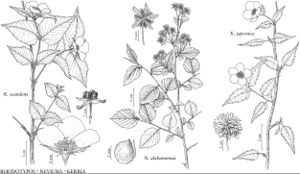Kerria japonica
Trans. Linn. Soc. London 12: 157. 1818.
Stems moderately flexuous. Leaves: stipules 1.5–2.5 mm; petiole channeled, 3–6(–9) mm; blade bicolored, (2–)3–6(–8.5) × (1–)1.5–3(–3.7) cm, base broadly cuneate to subcordate, proximal margins finely gland-tipped serrulate, ± plicate between impressed veins, apex long-acuminate, hairs 0.3–0.5 mm. Pedicels 5–22 mm, glabrous. Flowers: sepal margins entire, scarious, sometimes serrulate or glandular-fimbriate, apex acuminate, surfaces glabrous; petals (9–)17–25 × (2–)12–15 mm, claws 1–2 mm (innermost in multi-petaled cultivars showing transition toward stamens, 10 × 2–3 mm); filaments erect-ascending, straight, yellow, slender, 4–5 mm, anthers yellow, 0.2–0.3 mm. Nutlets 4–5 × 3.5–4 mm. 2n = 18.
Phenology: Flowering Mar–Jun; fruiting Jun–Aug.
Habitat: Moist suburban forests and woodlands, roadsides
Elevation: 0–700 m
Distribution

Introduced; N.S., Ont., Ala., Conn., Ill., Mich., N.H., N.Y., N.C., Ohio, Pa., R.I., S.C., Tenn., Utah, Va., e Asia (China, Japan), introduced also in Europe.
Discussion
Kerria japonica is cultivated in central Europe and North America, particularly in the east, as a shade-tolerant ornamental shrub. The species persists long after cultivation and spreads mostly vegetatively, apparently only rarely spreading by seed. It is expected elsewhere. The cultivar 'Pleniflora' has multiple petals appearing as a yellow-orange rose.
Selected References
None.
